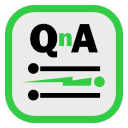RapidQandA

RapidQandA — the fastest way to create your quizzes and lessons from plain old text.
🎲 One problem, five ways
During the Learning Trail we’ve come across five different problem types. Let’s look at how we could use these five different types for the same question.
A slideshow
A slideshow just presents information; it doesn’t set any questions that need to be answered. Here’s our lesson as a slideshow:
(i)Albert Einstein was born in Ulm in the German Empire in 1879.
He is perhaps best known for developing the theory of relativity.
In 1905, a year known as his 'miracle year', he published four groundbreaking papers.
In 1915, he proposed a general theory of relativity.
In 1921 he received the Nobel Prize in Physics.
In 1933, he emigrated to the United States.
He died in 1955.
A multiple choice question with one correct answer
Here is another problem but this time as a multiple choice question. The right answer is identified with an = indicator and the wrong answers with x indicators. Note that with the exception of order problems, the order you write the wrong and right answers doesn’t matter.
(?) When was Albert Einstein born?
x 1881
= 1879
x 1900
x 1912
A multiple choice question with more than one correct answer
Here we have a problem where more than one correct answer has to be selected.
(?) Which of these statements about Albert Einstein are true?
= He was born in 1879
= He developed the theory of relativity
x He discovered Australia
x He invented the pencil
A missing word problem
We’re still on Albert, but now we’ll pose a missing word problem.
(?) Fill in the missing words.
The scientist ...Albert Einstein developed the theory of ...relativity.
x Edgar
x everything
x relationships
x William
Notice how we’ve added more wrong answers with the x indicators. They get added to the possible options for the missing words.
Finally an order problem
The last type of problem we have is the order problem.
(?) Put these facts about Albert Einstein in the correct chronological order, starting with the earliest. 123>column
= Publishes four groundbreaking papers in his 'miracle year'
= Proposes a general theory of relativity
= Receives the Noble Prize for Physics
= Emigrates to the United States
The end of the learning trail
You’ve now seen how to create all the different problem types and also how they can be used to present the same information in different ways. That’s the end of the learning trail, but there’s still more to uncover.
At the moment, we’ve kept everything fairly simple — we’ve not looked at adding bullets or images for example. To enhance your lessons, take a look at the Contents for more advice about getting the most out of RapidQandA.